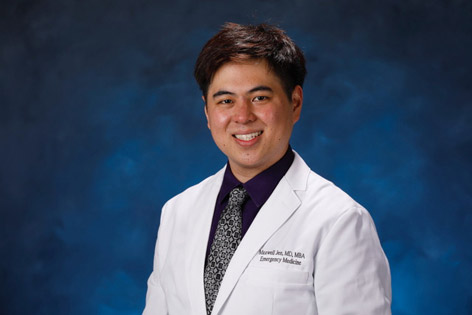 |
New Triage System Improves Resource Allocation and Emergency Patient Flow
We recently met with Dr. Maxwell Jen to talk about the new triage system put in place at the UC Irvine Medical Center emergency department. Dr. Jen is the Associate Medical Director for the Department of Emergency Medicine.
One of the first processes a patient goes through when they arrive at the ED is “triage.” Triage is a process by which physicians and nurses optimize the allocation of limited resources or space by carefully assessing patients differing levels of need for immediate medical treatment. This way, physicians can ensure that patients receive appropriate care in a timely manner, and the most acute patients receive care first.
Last year, the Department of Emergency Medicine changed the way physicians working triage were scheduled. Under the previous triage system, an emergency physician might see 20 to 30 patients during an eight-hour shift. Under this system, physicians initiated their treatment from the waiting room, and the remainder of the care was managed by the attending physician in the main emergency department (ED). Given that the triage process is cognitively and physically demanding and the decisions being made significantly impact patient well being, these triage shifts were demanding. Additionally, patients were being evaluated by two different attending physicians, which could pose further challenges. Since January 2018, physicians now triage patients for three hours and then complete the remainder of their shift in the main ED. This splits the cognitive and physical workload among seven physicians throughout the day and allows physicians to continue to care for the patients they evaluate, thereby improving continuity of care.
To further improve resource allocation and flow within the emergency department and better accommodate our patients, a second change to the triage system was implemented July 2018. To best address patient boarding, a significant amount of new patient care had moved towards the “front” of the ED (the waiting room) but would benefit from further support of nursing staff and diagnostic tools. The recent changes created evaluation areas in triage where patients could be fully assessed by physicians, increased “vertical spaces” or chairs where patients who are ambulatory could be treated in the main ED, and increased nursing support to care for patients in these areas. This moved diagnosis and treatment out of the “front” of the ED and into the main ED.
With this support and increase in treatment spaces, physicians and nurses together can focus on patient treatment to disposition (i.e. hospital admission or discharge,) thereby freeing up care spaces in the emergency department and initiating the care of the new patients. This shift in focus from the “front to the back” of the ED, along with scheduling and flow changes with the new triage system, ensures that patient care is prioritized while dispersing the burden placed on ED physicians and nurses.
Thank you to Arnie Shah, MS2 for his assistance with this article.
